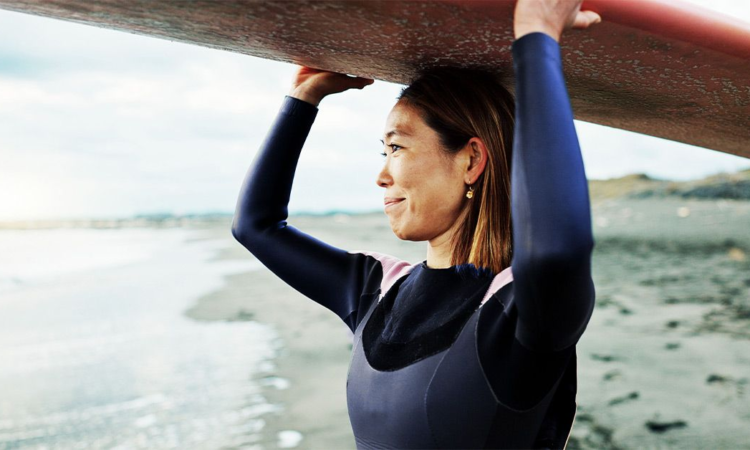
Women who exercise consistently in midlife have better health-related quality of life.
That’s according to research published today in the journal PLOS Medicine in which researchers reported that women in their 40s and 50s who consistently adhered to physical activity guidelines had better physical functioning than their peers who didn’t consistently exercise.
“Combined with existing evidence, this study contributes to growing evidence of the benefits of maintaining or adopting an active lifestyle in mid-age,” the study authors said in a press statement.
“An important public health message is that being active for as many years as possible, even if women start to meet physical activity guidelines in their mid-50s, could have important health benefits in terms of physical health, especially in physical functioning,” they added.
The researchers from Australia examined data from more than 11,000 women beginning in 1996. The women were born between 1946 and 1951, meaning they were 47 to 52 years of age when the study began.
The participants were categorized into those who met the
The quality of life related to the health of the women was assessed using a physical health composite score. This was derived from a survey that asked 36 questions about functional health and wellbeing.
The researchers reported that women who met the physical activity guidelines as well as those who first began meeting these guidelines when they were 55 had a 3 point higher physical health composite score than women who didn’t meet the guidelines.
The study authors said that “women should be active throughout mid-age, ideally increasing activity levels to meet the guidelines by age 55, to gain the most benefits for physical health in later life.”
The World Health Organization
Alternatively, it is recommended adults should do at least 75 to 150 minutes of vigorous intensity aerobic physical activity or an equivalent combination of activity of both moderate and vigorous intensity.
Adults should also engage in muscle strengthening activity two or more days each week.
“We have very good evidence that physical activity is one of the best things women can do to keep themselves healthy throughout their lifespan. It doesn’t do us any good to live for many years if we are unable to do all the things we need and want to do to enjoy that time. Movement maintains good joint mobility and muscle strength, improves circulation, increases bone density, and helps prevent major diseases,” said Dr. Nicole Yedlinsky, a family medicine and sports medicine physician at The University of Kansas Health System who was not involved in the study.
“When we think about longevity, we don’t just want to live longer, we also want to live well,” Yedlinsky told Medical News Today. “Quality of life is extraordinarily important. Exercise is fundamentally important to all our body systems: our heart, lungs, brain, gut, joints, bones, and muscles. Regular physical activity is the key piece to minimizing the physiologic decline that normally comes with aging.”
The researchers found that women who began meeting exercise guidelines at age 55 still received the same benefits as their peers who had been consistently exercising prior to that.
Experts say midlife women, particularly those who are menopausal, should slowly ease in when beginning an exercise routine.
“All the symptoms of menopause can impede a woman’s ability to workout. Irregular periods make it hard to know when the best time of day is to work out. Hot flashes and night sweats make the thought of working out and breaking a sweat less desirable. Emotional upheaval including depression and anxiety also prevents trips to the gym or putting on your tennis shoes. Heart palpitations also scare menopausal women from doing any activity that increases the heart rate,” said Dr. Sherry Ross, an OB/GYN and women’s health expert at Providence Saint John’s Health Center in California who was not involved in the study.
“Starting slowly is recommended for menopausal women who are just starting to become physical active,” Ross told Medical News Today. “Getting into a regular routine is the best strategy. If you have any type of bone loss, especially osteoporosis, associated with aging and menopause, I would avoid exercises that may increase the risk of falling or create instability.”
While the benefits of physical activity are well established, the study authors note that for many women in this age group life transitions such as marriage, having children, children leaving the family home, retirement, and bereavement can influence activity level.
However, experts say it is important that midlife women take the time to prioritize their own health and quality of life by engaging in regular movement.
“The benefits of consistent exercise in quality of life become more clear when looking at the four functional benefits of many exercises; strength, stamina, flexibility and balance. The loss of any of these four types of physical capacity are hallmarks of physical infirmity and erosion of quality of life. For people looking forward to enjoying extended work or recreational activities as they age, loss of strength, stamina, flexibility and balance limit the scope of life and are predictors of loss of independent living capacity in older age,” said Dr. Charlie Porter, a cardio-oncologist at The University of Kansas Health System who was not involved in the study.
“‘Middle aged’ women are facing many demands from others and get little encouragement from anyone to take time for their own emotional and physical benefit,” Porter told Medical News Today. “This study provides encouragement for women in this stage of life to look at physical exercise for themselves as a way of sustaining and maintaining their own long term health and physical capacity. On an airliner, parents are instructed to put their own oxygen mask on before they put the mask on their children. Starting and staying with an exercise program in the time of life with maximum demands to serve others can be thought of like putting an oxygen mask on before helping others.”
Share this article
OUR BRANDS







